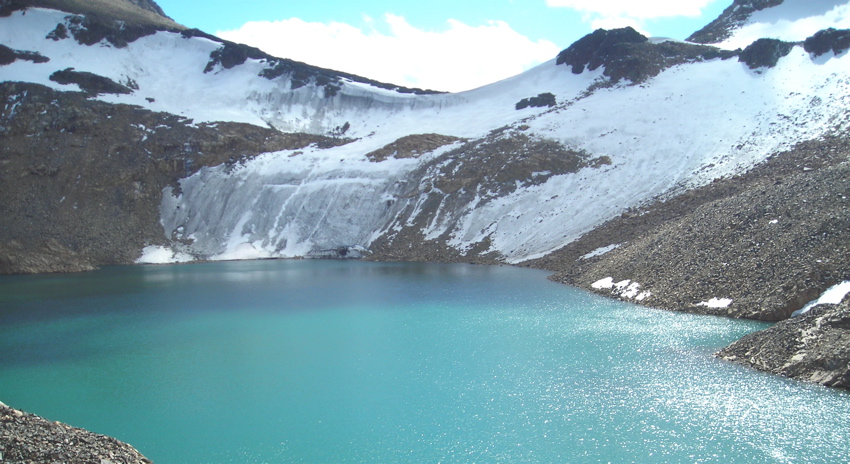|
Grasshopper Glacier North of Yellowstone Park
 Photo courtesy of Alexandre Lussier
Dept. of Physics, Montana State University
One of the most unusual "Earth Science places" in Montana is Grasshopper Glacier located 70 miles southwest of Billings (10 miles north of Cooke City). The Glacier, which sits at 11,000 feet in the heart of the Beartooth Mountains, takes its name from the millions of grasshoppers embedded within it. A study done by scientists in 1914 estimated the grasshoppers had been extinct for 200 years. More recently, entomologists identified the hopper as a species of migratory locusts (Melanoplus spretus) commonly called "Rocky Mountain Locusts".
Migration gone bad . . .
Centuries ago this species of locust was found in large numbers throughout the West. Scientists believe they became embedded in the ice when migrating swarms, passing over the high mountains, became chilled or were caught in a severe storm and were deposited on the glacier. As snow built up over decades, the grasshoppers were buried deeper and deeper. Then as the climate in the area has warmed over recent centuries, melting of the snow exposed the embedded grasshoppers, and they were discovered. Until recent years, visitors could dig perfectly preserved specimens from the ice. However, years of light snow during the winter and thawing during the summer months have exposed many of the grasshoppers to decomposition.
University of Wyoming study . . .
Fortunately there are other glaciers in the Rockies that also contain swarms of grasshoppers, and in the 1990s a team led by Jeffrey Lockwood, Professor of Entomology at the University of Wyoming, found one in Wyoming that contained intact grasshoppers. The team used radiocarbon dating to determine that the swarm was blown into the mountains in the early 1600s.
Glacier, or Snowfield? . . .
In order for a glacier to form there needs to be build-up of snow over many years. At lower elevations where most of us live, all of the snow that falls in the winter melts in the spring. At high altitudes that isn't always the case. For example, an average of 8 feet of snow might fall every winter, but only 3 feet melt away every summer, leaving a build-up of 5 feet of snow. When this goes on for decades these annual 5-foot layers form, one on top of the other, and begin to compress the layers beneath. As a result the snow nearer the bottom is changed into ice, and a glacier is born. Apparently not everyone is convinced that has happened with Grasshopper Glacier. Not enough snow built up to transform the bottom layers into ice, so technically Grasshopper Glacier is simply a "snowfield" that has been around for a very long time. But don't expect a name change anytime soon . . . "Grasshopper Glacier" has a much nicer ring to it than "Grasshopper Snowfield" does.
NOTE: In 2000, Grasshopper Glacier was approximately 1 mile long and 1/2 mile wide. Scientists believe it was over 4 miles long at its peak during colder times. Below: Robert Grebe took this photo of Grasshopper Glacier in September of 2010.  Photo courtesy of Robert Grebe
Terms: entomology, locust
| 


